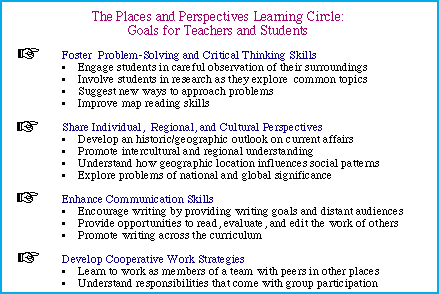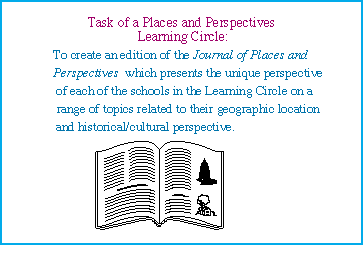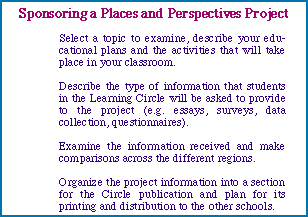 |
 |
|
 |
 |
||||||||||
Places and Perspectives Learning Circle The material in this section parallels the Teacher's Guide and presents suggestions or ideas that are specific to the Places and Perspectives Theme. This is an outline of the content in this section related to the different phases of Circle interaction. This file can be read from beginning to end to understand the Places and Perspectives theme. Or, using the "hypertext" links from the phase structure of Learning Circles, you can move easily back and forth from the general structure of a Learning Circle to theme specific examples. At the end of each set of theme related examples and ideas, there is a button to make it easy to return to the general description of the Learning Circle phase. OUTLINE OF THIS FILE:
Introduction to Learning Circles&endash;Places and PerspectivesPlaces and Perspectives Learning CirclePlaces and Perspectives encourages students to explore regional history, culture, government, and geography by sharing their knowledge with people from different locations. Often students assume that their lifestyles and thinking patterns are universal; they are unaware of differences. The goal of the Places and Perspectives theme is to expose students to places beyond their own schools and communities in order to expand their outlook on life and broaden their views. This helps students understand how historical events and geographic conditions interact to help shape their lives and gives them a deeper understanding of themselves, their families and their communities. Each classroom sponsors a project for a section in the Places and Perspectives Review. For instance, a classroom studying history may sponsor a section on local legends, interview native inhabitants or the elderly, or describe the historical attractions of the area. A classroom studying government might sponsor one of these sections: Examining local constitutions, Monitoring Elections, or Issues in Local Politics. A geography class may sponsor projects such as location descriptions, travel guides, comparisons of weather patterns, map studies, or studies on how geographic locations affect social patterns.
Educational GoalsThe purpose of this guide is to establish some common goals, to share ideas and suggestions from other teachers, and to support you in your teaching and learning through Learning Circles.

Learning Circle TaskTo accomplish this goal, teachers and students share a taskÑ the creation of a Circle publication featuring and summarizing the projects sponsored in your Learning Circle. This task will help students develop technical and computer expertise as they use the technology to accomplish important educational goals. 
Phase 1: Getting Ready&endash;Places and PerspectivesThinking about GeographyOne way to prepare students for their Learning Circle project is to discuss similarities and differences among people in different locations. Here are some ideas that might help you introduce the topic to your students.
Phase 3: Planning Places and Perspective Circle ProjectsSponsoring a Places and Perspectives ProjectSponsoring a Learning Circle project involves selecting a topic, proposing the type of information you want to receive from the other sites, organizing the project material exchanged on the network, and preparing a section on your project for inclusion in the Circle publication, the Journal of Places and Perspectives. 
An effective way to integrate networking with your classroom instruction is to take an activity that you already do in your curriculum and extend it by inviting students in different locations to contribute to it. For example, one New York teacher was doing a history unit on the Native American Iroquois tribe. One part of the project involved collecting local legends. She asked Learning Circle participants to share local legends, particularly those of any early indigenous people. This example illustrates the four characteristics shared by many of the successful Learning Circle projects. Here are some ideas for involving your students in the selection of your Learning Circle project.
Lesson Plans for Circle Projects --Places and PerspectiveYou are encouraged to select a project to sponsor that is
integrated with your curriculum. One of the ideas in this section may
be appropriate. It is likely that these ideas can be modified to fit the
work of your students. Or they may help you think of something from your
classroom that will work well on the network. Other teachers in your Learning
Circle are also a great resource for project ideas. You might want to
look through the Ask-Eric
archives of lesson plans in Social Some of the ideas are written to appeal more to younger students like "Backyard Dinosaurs," and "Local Animals," while others like "Land Use and Local Politics" are written for older students. However all topics can be modified to make them appropriate for any age student. Where in the World Are We If you cannot download images, a text only version of project ideas is also available. It is a good idea to print this form for listing your own project ideas as it is never too soon to start the planning process. Introducing your Places and Perspectives
|





 Return
to "Introduction to Learning Circles"
Return
to "Introduction to Learning Circles" Return
to List of Themes in the Overview
Return
to List of Themes in the Overview